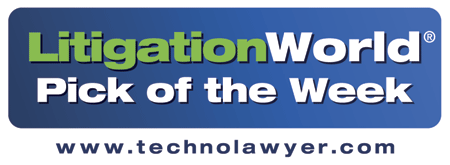eDiscovery Year in Review: eDiscovery Case Law, Part 4

As we noted the past three days, eDiscovery Daily has published 65 posts related to eDiscovery case decisions and activities over the past year, covering 50 unique cases! Yesterday, we looked back at cases related to discovery of social media. One final set of cases to review.
We grouped those cases into common subject themes and have been reviewing them over the next few posts. Perhaps you missed some of these? Now is your chance to catch up!
SANCTIONS / SPOLIATION
Behold the king! I’ll bet that you won’t be surprised that the topic with the largest number of case law decisions (by far!) related to eDiscovery are those related to sanctions and spoliation issues. Late in 2010, eDiscovery Daily reported on a Duke Law Journal article that indicated back then that sanctions were at an all-time high and the number of cases with sanction awards remains high.
Of the 50 cases we covered this past year, over a third of them (17 total cases) related to sanctions and spoliation issues. Here they are. And, as you’ll see by the first case (and a few others), sanctions requested are not always granted. Then again, sometimes both sides get sanctioned!
No Sanctions for Scrubbing Computers Assumed to be Imaged. In this case, data relevant to the case was lost when computers were scrubbed and sold by the defendants with the permission of the court-appointed Receiver, based on the Receiver’s mistaken belief that all relevant computers had been imaged and instruction to the defendants to scrub all computers before selling. Because of the loss of this data, defendants filed a motion for spoliation sanctions for what they described as “the FTC’s bad-faith destruction of Defendants’ computer systems.” Was the motion granted?
Spoliate Evidence, Don’t Go to Jail, but Pay a Million Dollars. Defendant Mark Pappas, President of Creative Pipe, Inc., was ordered by Magistrate Judge Paul W. Grimm to "be imprisoned for a period not to exceed two years, unless and until he pays to Plaintiff the attorney's fees and costs". However, ruling on the defendants’ appeal, District Court Judge Marvin J. Garbis declined to adopt the order regarding incarceration, stating it was not "appropriate to Order Defendant Pappas incarcerated for future possible failure to comply with his obligation to make payment…". So, how much was he ordered to pay? Now we know. That decision was affirmed here.
Deliberately Produce Wrong Cell Phone, Get Sanctioned. In this case, the plaintiff originally resisted production of a laptop and a cell phone for examination, but ultimately produced a laptop and cell phone. The problem with that production? After examination, it was determined that neither device was in use during the relevant time period and the actual devices used during that time frame were no longer in plaintiff’s possession. When requested to explain as to why this was not disclosed initially, the plaintiff’s attorney explained that he was torn between his “competing duties” of protecting his client and candor to the court. Really?
Destroy Data, Pay $1 Million, Lose Case. A federal judge in Chicago has levied sanctions against Rosenthal Collins Group LLC and granted a default judgment to the defendant for misconduct in a patent infringement case, also ordering the Chicago-based futures broker's counsel to pay "the costs and attorneys fees incurred in litigating this motion" where plaintiff’s agent modified metadata related to relevant source code and wiped several relevant disks and devices prior to their production and where the court found counsel participated in "presenting misleading, false information, materially altered evidence and willful non-compliance with the Court’s orders."
Conclusion of Case Does Not Preclude Later Sanctions. In this products liability case that had been settled a year earlier, the plaintiff sought to re-open the case and requested sanctions alleging the defendant systematically destroyed evidence, failed to produce relevant documents and committed other discovery violations in bad faith. As Yogi Berra would say, “It ain’t over ‘til it’s over”.
Written Litigation Hold Notice Not Required. The Pension Committee case was one of the most important cases of 2010 (or any year, for that matter). So, perhaps it’s not surprising that it is starting to become frequently cited by those looking for sanction for failure to issue a written litigation hold. In this case, the defendant cited Pension Committee, arguing that plaintiff’s failure to issue a written litigation hold and subsequent failure to produce three allegedly relevant emails allowed for a presumption that relevant evidence was lost, thereby warranting spoliation sanctions. Was the court’s ruling consistent with Pension Committee?
No Sanctions Ordered for Failure to Preserve Backups. A sanctions motion has been dismissed by the U.S. District Court of Texas in a recent case involving electronic backups and email records, on the grounds that there was no duty to preserve backup tapes and no bad faith in overwriting records.
Discovery Violations Result in Sanctions Against Plaintiff and Counsel. Both the plaintiff and plaintiff's counsel have been ordered to pay sanctions for discovery abuses in a lawsuit in Washington court that was dismissed with prejudice on June 8, 2011.
Meet and Confer is Too Late for Preservation Hold. A US District court in Indiana ruled on June 28 in favor of a motion for an Order to Secure Evidence in an employment discrimination lawsuit. The defendant had given the plaintiff reason to believe that emails and other relevant documents might be destroyed prior to Rule 26(f) meeting between the parties or Rule 16(b) discovery conference with the court. As a result, the plaintiff formally requested a litigation hold on all potentially relevant documents, which was approved by US Magistrate Judge Andrew Rodovich.
Court Orders Sanctions in Response to "Callous and Careless Attitude" of Defendant in Discovery. A Special Master determined that multiple discovery failures on the part of the defendant in an indemnity action were due to discovery procedures "wholly devoid of competence, yet only once motivated by guile". Accordingly, the court ordered sanctions against the defendant and also ordered the defendant to pay all costs associated with its discovery failures, including plaintiff's attorney fees and costs.
Court Upholds Sanctions for Intentional Spoliation of Unallocated Space Data. The Supreme Court of Delaware recently upheld the sanctions against the defendant for wiping the unallocated space on his company’s computer system, despite a court order prohibiting such destruction. In this case, Arie Genger, CEO of Trans-Resources, Inc., argued that sanctions against him were unreasonable and made a motion for the court to overturn its previous decision regarding spoliation of discovery materials. Instead, after due process, the court upheld its earlier decision.
Sanctions for Spoliation, Even When Much of the Data Was Restored. A Virginia court recently ordered sanctions against the defendant in a case of deliberate spoliation of electronic discovery documents. In this case, the defendant was found to have committed spoliation "in bad faith" in a manner that constituted a "violation of duty… to the Court and the judicial process."
"Untimely" Motion for Sanctions for Spoliation Denied. A recent ruling by the US District Court of Tennessee has denied a motion for sanctions for spoliation on the grounds that the motion was "untimely." In this case, the plaintiff argued that the defendants' admitted failure to preserve evidence "warrants a harsh penalty," but the court found in favor of the defense that the motion was untimely.
Defendant Sanctioned for Abandonment and Sale of Server; Defendants' Counsel Unaware of Spoliation. An Illinois District Court ordered heavy sanctions against the defense for spoliation "willfully and in bad faith" of documents stored on a server, in a case revolving around damages sought for breach of loan agreements.
Facebook Spoliation Significantly Mitigates Plaintiff’s Win. In this case with both social media and spoliation issues, monetary sanctions were ordered against the plaintiff and his counsel for significant discovery violations. Those violations included intentional deletion of pictures on the plaintiff’s Facebook page as instructed by his Counsel as well as subsequent efforts to cover those instructions up, among others.
Lilly Fails to Meet its eDiscovery Burden, Sanctions Ordered. In this case, a Tennessee District court found that “Lilly failed to take reasonable steps to preserve, search for, and collect potentially relevant information, particularly electronic data, after its duty to preserve evidence was triggered by being served with the complaint.” As a result, the court ordered sanctions against Lilly. How far did the court go with those sanctions?
Court Grants Adverse Inference Sanctions Against BOTH Sides. Have you ever seen the video where two boxers knock each other out at the same time? That’s similar to what happened in this case. In this case, the court addressed the parties’ cross motions for sanctions, ordering an adverse inference for the defendants’ failure to preserve relevant video surveillance footage, as well as an adverse inference for the plaintiff’s failure to preserve relevant witness statements. The court also awarded defendants attorneys’ fees and costs and ordered re-deposition of several witnesses at the plaintiff’s expense due to other plaintiff spoliation findings.
Next week, we will begin looking ahead at 2012 and expected eDiscovery trends for the coming year.
So, what do you think? Of all of the cases that we have recapped over the past four days, which case do you think was the most significant? Please share any comments you might have or if you’d like to know more about a particular topic.






